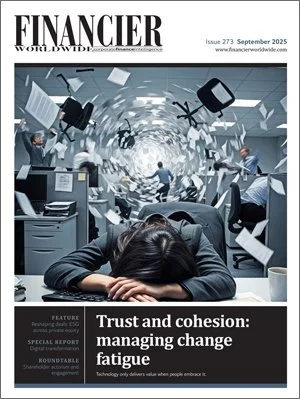Unpacking EPR: rethinking product lifecycles
September 2025 | FEATURE | RISK MANAGEMENT
Financier Worldwide Magazine
In today’s consumer-driven society, products are mass-produced with often little consideration for their environmental impact – a lack of accountability that poses a serious threat to global sustainability agendas.
As consumption continues to rise, emissions linked to resource use and consumer demand now account for around 45 percent of global greenhouse gas (GHG) emissions, according to the UK’s Waste and Resources Action Programme (WRAP). Clothing and footwear alone contribute approximately 8 percent of this total.
WRAP also reports that 12.6 million tonnes of textile waste are generated annually in the European Union (EU), 17 million tonnes in the US and 1.7 million tonnes in Japan. In the electronics sector, producing just one kilogram of goods emits 25 kilograms of carbon. Globally, 57 million tonnes of electronic waste are produced each year, contributing roughly 1425 million tonnes of carbon emissions.
In the US, less than half of the 80 million tonnes of packaging generated annually is recycled. Additionally, around 50,000 mattresses are sent to landfill each day, despite most being recyclable. The country also disposes of approximately 80 million gallons of leftover paint each year.
Given the environmental and financial costs of waste management, addressing problematic waste streams is essential. WRAP and similar organisations see a clear opportunity to collaborate with governments and businesses to tackle this growing challenge. A key part of the solution is extended producer responsibility (EPR).
Understanding EPR
EPR is an environmental policy approach that makes producers responsible for the environmental impact of their products throughout the entire lifecycle – from material selection and design to end-of-life management, including take-back schemes, recycling and disposal.
“EPR legislation is, at its core, designed and intended to improve recovery rates and minimise environmental impacts for regulated products,” says Joseph Dages, a partner at Steptoe. “It sounds simple, but in practice EPR laws can vary considerably across different target products. For example, an EPR regulatory scheme for mattresses will be quite different to one for packaging.
“With packaging now at the forefront of legislative action, EPR is rapidly reshaping the regulatory and business landscape in the US, the UK, the EU, and beyond.”
“Even within product categories, there can be considerable variability across jurisdictions,” he continues. “In the US, EPR laws for packaging at the state level provide a good example of this variability – each of the seven state packaging EPR laws are different, and can go beyond conventional EPR to include other concepts, like labelling restrictions or source reduction requirements.”
Compliance obligations
For businesses, complying with EPR regulations can be complex due to inconsistent legislation, high compliance costs, and the challenges of data collection and reporting. In the US, a patchwork of state-specific requirements places a significant burden on companies, especially those operating nationwide.
According to Mr Dages, companies must first determine whether they qualify as a ‘producer’ under EPR law. Typically, this refers to the brand owner of the packaged product, not necessarily the manufacturer of the packaging itself.
If a company meets the definition of a producer, it must then assess whether it markets any ‘covered products’. Definitions vary by state, with some laws focusing solely on packaging and others including paper products and foodservice ware.
Once identified as a producer of covered products, the company must join a producer responsibility organisation (PRO). These non-profit entities help producers meet their legal obligations for recycling and waste management.
“The PRO is a non-profit that works with the state to fulfil the legal mandates in the applicable EPR law, which in the case of packaging, entails improving packaging recovery rates,” adds Mr Dages. “Then the company needs to report material type and tonnage to the PRO, and pay fees into the PRO.”
EPR targets should also be reviewed and updated regularly to reflect changes in market conditions and technological advancements.
Scope for improvement
While EPR schemes have successfully shifted some of the financial burden for waste management from municipalities and taxpayers to producers, progress remains uneven. Many countries could improve their EPR performance by learning from more effective models.
Although some nations are still in the early stages of implementing EPR frameworks, the Organisation for Economic Co-operation and Development suggests that businesses can enhance their outcomes by focusing on cost-effectiveness and improving product design.
“In the US, it is too early to tell if EPR laws will be effective,” concludes Mr Dages. “Certainly, a lot of investment is happening, and will continue to happen, so it seems likely that packaging recovery rates will improve in the states that have adopted EPR laws for packaging. Some states are still in the very early stages of implementing the laws, while in others, rulemakings have yet to begin.”
With packaging now at the forefront of legislative action, EPR is rapidly reshaping the regulatory and business landscape in the US, the UK, the EU, and beyond. As more countries adopt EPR frameworks, businesses must adapt to evolving compliance obligations, changing cost structures and increasingly complex producer responsibilities.
© Financier Worldwide
BY
Fraser Tennant


